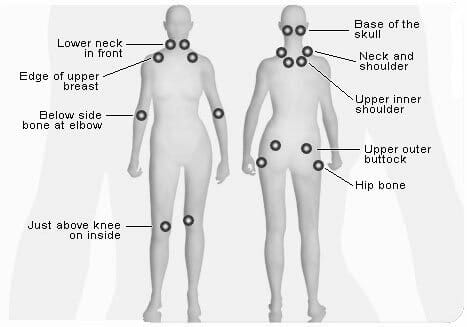Pain is something that everybody will experience in their lifetime. However, with conditions such as fibromyalgia, the struggle with pain is ongoing and often difficult to cope with.
Often this problem is exacerbated by incorrect diagnoses and treatments, which allows the condition to continue unabated.
One of the key reasons for this is that fibromyalgia is a notoriously tricky condition to diagnose. Since individuals have different perceptions of pain and different levels of tolerance, it can often be difficult for medical professionals to get a sense of the pain levels experienced by the patient.
However, one useful trick in coming to a conclusive diagnosis is the use of pressure points across the body.

There are nine specific pairs of pressure points that, when pressed, can often spread pain to the rest of the body.
Should a significant number of these pressure points cause pain, it can help come to a conclusive diagnosis.
While these can be a helpful start, they cannot be relied upon for an official diagnosis since fibromyalgia has a range of symptoms. Always consult a doctor if you are experiencing significant pain.
These tender spots are fleshy areas that contain a lot of connective tissue and muscle, and the pain that is described is usually tenderness and sensitivity to touch which refuses to go away.
If the pain you are experiencing is in your joints, it is most likely not associated with these points, as it is the sensitive soft tissue that is primarily being affected.
Checking yourself for sensitive spots can help you to get an idea of your level of pain and sensitivity, which can help you better communicate your problems to medical professionals and ultimately seek help with your condition.
The first pair of pressure points can be located on either side of the back of the neck. Pain in the neck is a symptom of many things, such as injuries, poor posture, or other conditions such as arthritis.
However, if the pain spreads when pressure is applied to the soft tendons at either side of the spine where the neck meets the skull, it can be a symptom of fibromyalgia.
The front of the neck is also a common pain point, with the flesh at either side of the larynx often causing significant pain in sufferers of the condition.
The crease of the elbow, where the flesh of the arm folds over itself, is an area that can often be tender and painful.
The hips are another common part of the body in which to feel pain. While hip pain is commonly associated with joint conditions such as arthritis as well as age-related wear and tear, sufferers of fibromyalgia more often feel pain between the buttock and the thigh.
The fleshy crease between the thigh and the buttock in particular is commonly associated with pressure sensitivity.
The top of the buttock is another pair of pressure points but is commonly mistaken for lower back pain.
Lower back pain typically occurs higher than this, starting just below the rib cage, while fibromyalgia pain is located just where the hem of your trousers would sit.

Higher back pain can also be an indication, with the tendons at the top of your back being one of the bigger and more noticeable areas often affected.
The shoulders themselves can also be an indicator, with the joint between the bottom of the neck and the top of the shoulders being particularly tender.
Knee pain is not uncommon in most people. Some may suffer knee stiffness after sitting too long or from sustaining an injury during exercise.
Similarly, like hip pain, the knee is a joint commonly affected by age-related wear and by conditions such as arthritis.
However, the bone joint is not necessarily the part affected by fibromyalgia, and the pain is usually more noticeable in the pad of the knee, around the back of the leg.
Lastly, chest pain is another typical tender point for fibromyalgia pain, with the breast tissue and muscles surrounding the sternum and collarbones being the suspect areas.
Pain that occurs in the body can be due to any number of afflictions or minor issues, but it is one of the most essential diagnostic tools.
Pain in the aforementioned areas can be a good indication that there is a problem, particularly if the pain is sudden onset or lasts for extended periods.
Similarly, if the pain spreads significantly with the application of pressure, it is a common symptom of fibromyalgia and should be discussed with a medical professional.
Tenderness and sensitivity to touch are symptoms that are often overlooked for long periods, which can often mean that people suffer far longer than they need to.
Of course, if you feel pain in one or two of these areas it is usually no cause for alarm, and you should not panic over a slight pain in the hip or knee.

However, if you notice prolonged pain or spreading pain from a significant number of the above-noted areas, you should consult your doctor and describe your symptoms to them.
Always be honest and open with your physician about your pain, as a firm diagnosis early on can be a great help in living with fibromyalgia.
Chronic pain is not the only symptom of fibromyalgia. The condition affects the body in several ways and can cause pain across the body – even in places other than those noted above – as well as lethargy and other such problems.
Experiencing some of the most notable symptoms of fibromyalgia should prompt you to seek medical help, as catching the condition early will allow you to start treating the condition.
If you’ve been diagnosed with fibromyalgia it can often be difficult to know what to do. Many people struggle with coming to terms with their illness and many more simply don’t know what to expect.
Keeping yourself informed about different symptoms to look out for and coping mechanisms is essential to living with fibromyalgia.
